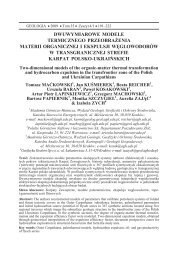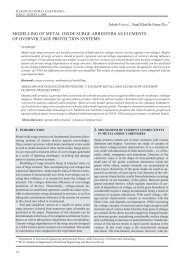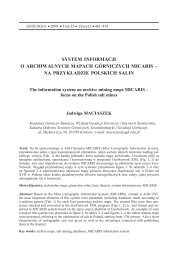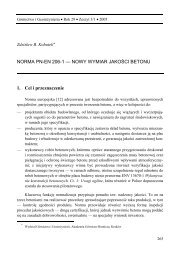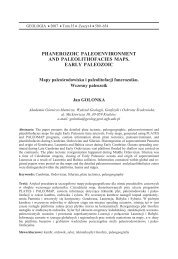You also want an ePaper? Increase the reach of your titles
YUMPU automatically turns print PDFs into web optimized ePapers that Google loves.
142 J. Wachowiak, M. Pawlikowski & P. Wilkosz<br />
ANALYSIS<br />
OF WATER-INSOLUBLE (HARDLY WATER SOLUBLE)<br />
PART CONTENTS<br />
SEPARATED FROM THE ROCKS<br />
OF BOREHOLES Z-9 AND Z-17<br />
The water-insoluble (hardly water soluble) mineral contents of the rocks obtained from<br />
boreholes Z-9 and Z-17 ranged from 0.14% to 14.7% by weight. The largest proportion of<br />
water-insoluble residue was found in zubers (samples 9/863 and 9/1113) and the rock salts<br />
with large admixtures of anhydrite (samples 9/1530, 17/663, and 17/954). The smallest proportions<br />
of insoluble parts were observed in potash salts, with a large proportion of kieserite,<br />
determined to be kieseritic sylvinite. That was associated with a very small quantity of<br />
anhydrite in those salts (sample 9/1116 – 0.2%, sample 17/827 – 0.14%). However, the insoluble<br />
part contents were oscillating around 1–3% in the majority of rock salts. Anhydrite is<br />
the dominating mineral of hardly water-soluble residue. Its contents amounted to 98–100%<br />
in the majority of samples. In addition, the presence of such minerals as quartz, magnesite,<br />
dolomite, calcite, boracite, pyrite, talk, chlorite, illite, hematite, and gypsum was determined<br />
(Gypsum, found in zubers in the form of idiomorphous crystals, is most probably a presentday<br />
epigenetic mineral). They occurred in accessory quantities, and their proportions ranged<br />
from tenths of a percent to 2%.<br />
The granulation of insoluble parts, separated from salt rocks of boreholes Z-9 and Z-17<br />
indicated considerable changeability, from clay fraction of several microns (in clay salts and<br />
zubers) to several centimetre large in zubers and some chloride rocks. In coarse fractions<br />
of > 2 mm, mainly microcrystalline debris of anhydrite and carbonate-clay-sand rocks<br />
were located (in zubers). In samples 17/1203 and 17/1237, collected from potash salt layers,<br />
a considerable presence of large monocrystal anhydrites of up to 1.5 cm were found.<br />
In medium fractions, from 2 mm to 0.1 mm, mainly forms of monocrystalline anhydrite<br />
and some accessory minerals (authigenic quartz, carbonates, boracite, and pyrite) were located.<br />
The nest fractions of less than 0.1 mm were created by anhydrite, allogenic quartz,<br />
carbonates, and clay minerals which shifted to pelite fraction. A large majority of waterinsoluble<br />
material was concentrated in the fractions of 0.6–0.1 mm, with usually more<br />
than 80% share.<br />
In the granulometric distribution of residue, regularity was observed, consistently repeating<br />
in all analysed rock salt samples. In the rock salts of cyclothem PZ-2, a large majority<br />
of insoluble parts were located in the range of 0.25–2.0 mm, while in case of the rock<br />
salts of cyclothem PZ-3, insoluble parts had smaller dimensions and they were located in the<br />
fractions of < 0.25 mm (Tab. 1, 2, Fig. 11). That difference was associated mainly with the<br />
anhydrite grain sizes. That regularity was also observed in the Kodawa diapir evaporites.<br />
A clear difference found in the granulometric distribution of water-insoluble residue of<br />
the rock salts of cyclothems PZ-2 and PZ-3 was one of valuable diagnostic petrographic features<br />
allowing us to distinguish those sediments.



